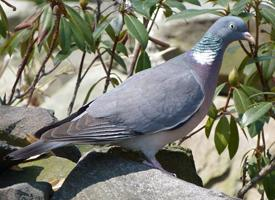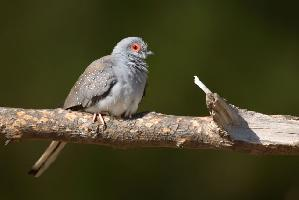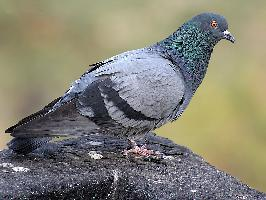
Súlyok és méretek
| Hossz | 33 cm |
|---|---|
| Súly | 300 g |
Állatleírás
The Stock Dove (Columba oenas) is a bird species belonging to the family Columbidae, which includes doves and pigeons. It is a medium-sized, compact bird, slightly smaller than the common wood pigeon. The Stock Dove typically measures about 30 to 33 centimeters in length, with a wingspan ranging from 62 to 68 centimeters, and weighs between 200 to 300 grams.One of the most distinctive features of the Stock Dove is its plumage, which exhibits a combination of soft, bluish-grey on the head, neck, and upperparts, with a slight iridescent sheen on the neck and chest. This sheen can appear green or purple depending on the light. The breast is paler than the rest of the body, often showing a hint of rosy-pink. Unlike the wood pigeon, the Stock Dove lacks white patches on its neck and wings. Instead, it has two black bars on its wing feathers that are visible during flight.
The eyes of the Stock Dove are dark red or deep brown, encircled by a narrow, bare skin ring that is typically a pale, greyish color. Its beak is slender and grey, with a white cere (a soft, fleshy swelling) at the base. The legs and feet are a reddish-pink, contributing to its delicate appearance.
Stock Doves are known for their soft, purring calls, which are less boisterous than those of other pigeons. These calls are often heard during their breeding season and are a part of their courtship rituals.
In terms of habitat, Stock Doves are versatile and can be found across Europe and into parts of western Asia. They prefer open woodlands, farmland edges, parklands, and even large gardens, as long as there are suitable nesting sites. Unlike many other pigeon species, Stock Doves often nest in tree cavities, old woodpecker holes, or in crevices of buildings and ruins. They are also known to use nest boxes if available.
Stock Doves are monogamous and typically form long-term pair bonds. Their diet consists primarily of seeds, grains, and occasional invertebrates, which they forage for on the ground. They have a swift, direct flight, and when disturbed, they can take off with an explosive burst of speed, a trait that helps them evade predators.
The breeding season for Stock Doves begins in spring. They lay two or three white eggs per clutch, and both parents share incubation duties for about 17 to 19 days. Once hatched, the squabs (young doves) are fed a nutritious secretion known as "crop milk," produced by the lining of the parents' crops. The young fledge in about 30 days but may remain dependent on their parents for a short while thereafter.
Conservation-wise, the Stock Dove is considered to be of least concern by the International Union for Conservation of Nature (IUCN), although its populations are affected by habitat loss and changes in agricultural practices. Overall, the species remains widespread and relatively common within its range.
Hasonló állatok
Új állatfotók
Top 10 állat
- Dolphin gull (Leucophaeus scoresbii)
- Diana monkey (Cercopithecus diana)
- Japanese macaque (Macaca fuscata)
- Galápagos tortoise (Geochelone nigra complex)
- Stone loach (Barbatula barbatula)
- Moustached guenon (Cercopithecus cephus)
- Russian tortoise (Testudo horsfieldii)
- Common house mosquito (Culex pipiens)
- Japanese spider crab (Macrocheira kaempferi)
- Giant peacock moth (Saturnia pyri)


